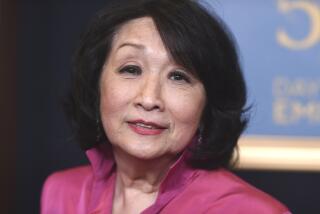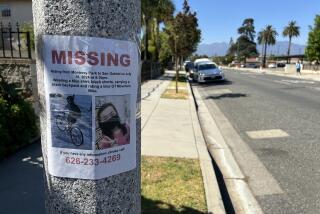Chandra Levy Mystery Stirs Memories of Equally Baffling D.C. Disappearance
- Share via
WASHINGTON — Early on in their hunt for missing Modesto intern Chandra Levy, District of Columbia police and FBI search teams combed through the weeds in Anacostia Park, a grassy stretch along the north bank of the Potomac River. They left with no answers--just as they had three years ago when they scoured the same terrain in another baffling disappearance.
The searchers massed in Anacostia Park in early May to look for links between Levy’s disappearance and the 1999 death of Joyce Chiang, a 28-year-old government lawyer missing for three months until her body washed up on the Virginia side of the river. Police found nothing in the weeds, and investigators say that further scrutiny of the two cases over the last two months has repeatedly struck dead ends.
“We wanted to assure ourselves that there were no common connections,” said Cmdr. Jack Barrett, the District of Columbia Metropolitan Police Department’s chief of detectives. “At this point, we still haven’t found any.”
But echoes from the Chiang case haunt the search for Levy.
Chiang’s death remains unsolved. There are enough nagging similarities between the two women and their disappearances that many of Chiang’s relatives and friends have wondered aloud in recent weeks about the possibility of foul play committed by strangers.
Both women were Californians, slight, outwardly upbeat. Both lived within five blocks of each other, disappearing in the area near Washington’s Dupont Circle, a crowded district of clubs and coffee shops surrounded by dimly lit streets that empty at night. And the lack of evidence of a crime in both cases has led investigators to speculate openly about suicide.
Chiang’s relatives, a tightknit Los Angeles family with Democratic Party connections, believe she was murdered. Chiang’s circle of government co-workers and political friends talk of a fatal abduction.
While investigators talked early about the possibility that Chiang committed suicide or was in hiding, even a city police detective assigned to Chiang’s case considered foul play a possibility.
“It’s odd that you hear every other theory than the one that’s the most feared,” said Rep. Howard L. Berman (D-Mission Hills), who hired Chiang as a legislative aide before she became a federal immigration lawyer.
The idea that both women might have been stalked by strangers has also been explored by a lawyer for Rep. Gary A. Condit (D-Ceres). In recent days, as Condit was questioned for the second time by detectives about his personal relationship with Levy, his San Francisco lawyer, Joseph Cotchett, asked police to provide other unsolved missing person reports from the area around Dupont Circle.
Police investigators insist there are strong reasons why they are concentrating on Levy’s dealings with Condit and exploring suicide or intentional hiding as theories--while playing down the Chiang case and the likelihood of foul play by strangers.
FBI Has Suspected Suicide by Chiang
Authorities say FBI agents have long suspected Joyce Chiang committed suicide--although the bureau will not openly discuss details of their investigation.
As district police detectives investigating Levy’s disappearance pored over old criminal cases in recent weeks, they found no suspicious reports of missing persons from the Dupont Circle area, Barrett said. Investigators also found little evidence of street abductions in the Dupont Circle area--a neighborhood where the most common crimes are street robberies and low-level drug trade.
“We just haven’t seen that kind of crime around here,” said D.C. Police Cmdr. Mark Beach, who commands “3D,” the crowded 3rd Police District in downtown D.C. that includes Dupont Circle.
Detectives investigating the Chiang case tried to amass similar reports of downtown abductions three years ago but found only two files, said Det. Stephen McDonald. In one case, several men forced a woman into a van on a street in Georgetown and raped her before letting her go. In a second case, a man tried to pull a woman into a car near the Mall south of the White House. The woman escaped; the assailant was not found.
Despite concluding they had no relation to the Chiang case, McDonald, who is still assigned to her disappearance, considers foul play a possibility.
He is bothered by the suicide theory, McDonald said, “because [Chiang’s] body was found so far [8 miles] from where she disappeared. A suicide wants the body to be found.”
Joyce Chiang gave no hint of depression on Jan. 9, 1999, the day she vanished. That Saturday, she went shopping, then met at a coffee shop with Patty First, a friend and Justice Department staffer. “She was in good spirits, but then she always was,” First recalled.
Chiang later joined another friend at a downtown movie theater. When the film ended, the friend offered Chiang a ride home. Chiang declined. “Joyce told her she wanted to get a cup of tea,” First said.
When Chiang failed to return the next day, her brother Roger Chiang, who shared her ground-floor apartment, was unfazed. “I figured she stayed overnight with a friend,” said the former Clinton campaign advance man.
She did not show up that Monday at her job in the headquarters of the U.S. Immigration and Naturalization Service. She was still missing the next morning, prompting her brother to call the FBI. “It just wasn’t like her,” he said. “She was the most responsible person I knew.”
Joyce Chiang was the daughter of Taiwanese immigrants who raised four children in the Chicago suburbs, then in Los Angeles. Brother John Chiang is now an elected member of the California State Board of Equalization. Roger splits his time between D.C. and Philadelphia after working in the Clinton administration. A third brother, Robert, is in Texas.
The siblings all gravitated toward politics. Still in high school, Joyce volunteered for Berman in Los Angeles, then took a series of congressional internships in the District of Columbia and night courses at Georgetown Law School. Hired as a full-time aide in 1992, “she was wonderful,” recalled Gene Smith, Berman’s chief of staff. “Smart, resourceful, always cheery--we hated to lose her.”
She took a job with the INS in 1995, working on legislation in the agency’s congressional affairs section. “She really thrived there,” First said.
Outside work, she was intensely private. She dated, mostly men she knew from either law school or government circles, said Anieszka Fryzman, a lawyer friend.
Safety was not an issue for her, friends said, as she shopped along Connecticut Avenue and hung out at coffee shops there. “She was pretty streetwise,” First recalled.
But there were incidents. She complained to her brother about a man who followed her on the subway. Friends said she mentioned a “peeping Tom” incident. “She was kind of a magnet for street people,” First said.
They later cited those episodes to the FBI as leads worth pursuing. But the stories were too vague, investigators say, to act on.
When Chiang vanished, her family assumed the worst. Unlike in the Levy case, the FBI quickly became the lead investigator--asked to intervene by Berman and other federal officials who knew the Chiangs.
Agents moved quickly. Friends and associates were interviewed. Roger Chiang volunteered to take a polygraph test. The results were inconclusive--the brother insisted his nervousness affected his answers. There were no follow-ups.
As the weeks wound on, Chiang’s friends grew angry. Their tales about her street incidents were ignored, they complained. Roger Chiang’s relations with FBI agents frayed. The Chiangs and others say agents kept harping on suicide, even on a staged suicide--much as police now cite in the Levy case.
Chiang Was Under INS Internal Probe
Barrett, who now runs the Levy probe, was then the FBI supervisor overseeing the Chiang investigation. He said agents did their best but were unable to satisfy Chiang’s relatives and friends.
As they questioned INS officials, FBI agents learned Chiang was under an internal investigation. Barrett would not discuss details of the allegations but said Chiang had faced a formal interview the week after she disappeared. Her stress, FBI agents theorized, might have been motive for suicide.
As winter thawed into spring, physical evidence began turning up. A government identity card with Chiang’s name was found in Anacostia Park. More searches in the area--near a pedestrian bridge where several people had attempted suicide leaps--turned up a jacket worn by Chiang the night she vanished.
Then, in April, a body floated ashore on the Virginia side of the Potomac. It was too deteriorated for identification, and medical examiners could only identify the corpse from DNA strands and shredded clothing. It was Chiang’s. The cause of death could not be determined.
Roger Chiang and other friends acknowledge that there is little solid evidence supporting their contention of murder. But they point to her ripped jacket, a factor even McDonald said might suggest foul play.
Even Barrett has considered that possibility seriously. Just three days after Levy’s parents reported her missing, he sent searchers to Anacostia Park looking for similarities in the two cases. Despite his former agency’s tilt toward the suicide theory, he took no chances.
“Here we had two young women, about the same age,” he said. “We had undisclosed reasons for their disappearances. We wanted to be certain we explored every possible connection.”
But now, said Barrett, “all we have are two cases of young women who were in communication with family and friends, and then, nothing.”
More to Read
Sign up for Essential California
The most important California stories and recommendations in your inbox every morning.
You may occasionally receive promotional content from the Los Angeles Times.










